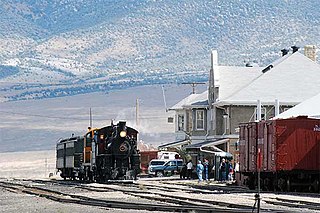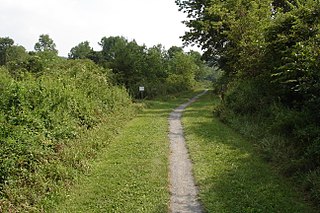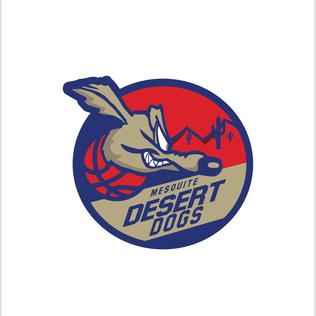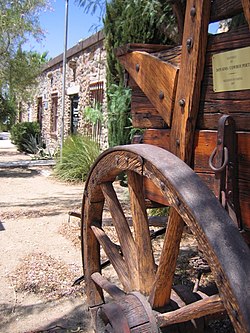
Death Valley National Park is an American national park that straddles the California–Nevada border, east of the Sierra Nevada. The park boundaries include Death Valley, the northern section of Panamint Valley, the southern section of Eureka Valley and most of Saline Valley.

Clark County is a county located in the U.S. state of Nevada. As of the 2020 census, the population was 2,265,461. Most of the county population resides in the Las Vegas Census County Divisions, which hold 2,196,623 people as of the 2020 Census, across 435 square miles (1,130 km2). It is by far the most populous county in Nevada, and the 11th most populous county in the United States. It covers 7% of the state's land area but holds 73% of the state's population, making Nevada the most centralized state in the United States.

Mesquite is a city in Clark County, Nevada, United States adjacent to the Arizona state line and 80 miles (130 km) northeast of Las Vegas on Interstate 15. As of the 2020 census, the city had a population of 20,471. The city is located in the Virgin River valley adjacent to the Virgin Mountains in the northeastern part of the Mojave Desert. It is home to a growing retirement community, as well as several casino resorts and golf courses.

The Virgin River is a tributary of the Colorado River in the U.S. states of Utah, Nevada, and Arizona. The river is about 162 miles (261 km) long. It was designated Utah's first wild and scenic river in 2009, during the centennial celebration of Zion National Park.

Rhyolite is a ghost town in Nye County, in the U.S. state of Nevada. It is in the Bullfrog Hills, about 120 miles (190 km) northwest of Las Vegas, near the eastern boundary of Death Valley National Park.

The Nevada Northern Railway Museum is a railroad museum and heritage railroad located in Ely, Nevada, owned by the State of Nevada and operated by a historic foundation dedicated to the preservation of the Nevada Northern Railway.

Downtown Las Vegas is the central business district and historic center of Las Vegas, Nevada, United States. It is the original townsite, and the Downtown gaming area was the primary gambling district of Las Vegas prior to the Strip. As the urban core of the Las Vegas Valley, it features a variety of hotel and business highrises, cultural centers, historical buildings and government institutions, as well as residential and retail developments. Downtown is located in the center of the Las Vegas Valley and just north of the Las Vegas Strip, centered on Fremont Street, the Fremont Street Experience and Fremont East. The city defines the area as bounded by I-15 on the west, Washington Avenue on the north, Maryland Parkway on the east and Sahara Avenue on the south.

The Old Spanish Trail is a historical trade route that connected the northern New Mexico settlements of Santa Fe, New Mexico with those of Los Angeles, California and southern California. Approximately 700 mi (1,100 km) long, the trail ran through areas of high mountains, arid deserts, and deep canyons. It is considered one of the most arduous of all trade routes ever established in the United States. Explored, in part, by Spanish explorers as early as the late 16th century, the trail was extensively used by traders with pack trains from about 1830 until the mid-1850s. The area was part of Mexico from Mexican independence in 1821 to the Mexican Cession to the United States in 1848.

Tonto National Monument is a National Monument in the Superstition Mountains, in Gila County of central Arizona. The area lies on the northeastern edge of the Sonoran Desert ecoregion, an arid habitat with annual rainfall of about 16 inches (400 mm). The Salt River runs through this area, providing a rare, year-round source of water.

A tin tabernacle, also known as an iron church, is a type of prefabricated ecclesiastical building made from corrugated galvanised iron. They were developed in the mid-19th century initially in the United Kingdom. Corrugated iron was first used for roofing in London in 1829 by civil engineer Henry Robinson Palmer, and the patent was later sold to Richard Walker who advertised "portable buildings for export" in 1832. The technology for producing the corrugated sheets improved, and to prevent corrosion, the sheets were galvanised with a coating of zinc, a process developed by Stanislas Sorel in Paris in the 1830s. After 1850, many types of prefabricated buildings were produced, including churches, chapels and mission halls.

Jacobsburg Environmental Education Center is a 1,168-acre (473 ha) Pennsylvania state park near Wind Gap, in Bushkill Township, Northampton County in Pennsylvania. The Jacobsburg National Historic District is almost entirely surrounded by the park. Jacobsburg Environmental Education Center is just off the Belfast exit of Pennsylvania Route 33.

Pueblo Grande de Nevada,, is a complex of villages located near Overton, Nevada, and listed on the National Register of Historic Places.

Mount Saint Mary's Convent and Academy, originally the Sacred Heart Convent and Holy Angels Orphanage and previously Mount St. Mary's Convent and Orphan Asylum, and also known as Mount Saint Mary's Academy and Convent, is the only extant original orphanage in California and commemorates the Sisters of Mercy, in Grass Valley, Nevada County, California.

Clackline is a locality in the Wheatbelt region of Western Australia, about 80 kilometres (50 mi) east-north-east of Perth.

LDS Moapa Stake Office Building, also known as the Virmoa Maternity Hospital, is listed on the National Register of Historic Places in Overton, Nevada. It was built between 1917 and 1919 to serve the community of Moapa Valley as a local office, classroom and records repository for the LDS Church. In 1939, the local stake decided to relocate their offices to Las Vegas as travel between the communities became easier. The building then sat vacant.

Walking Box Ranch, 7 mi (11 km) west of Searchlight, Nevada in the Mojave Desert, was founded in 1931 by the actors Rex Bell and Clara Bow as a working 400,000 acres (160,000 ha) ranch. The ranch covered 160 acres (65 ha) at the time it was listed on the National Register of Historic Places on January 30, 2009. The ranch includes four buildings and is owned by the Bureau of Land Management (BLM).

The Mesquite Desert Dogs were an American professional basketball team based in Mesquite, Nevada.

Eureka Casino Resort is a hotel and casino in Mesquite, Nevada. It initially operated under the name Rancho Mesquite. The hotel portion, originally part of the Holiday Inn chain, opened in August 1996. The casino opened on February 14, 1997. The Rancho Mesquite was owned by the Lee family, who were the only Nevada casino owners to be of Asian descent. Because of confusion with other businesses, the name was changed to Eureka in 2000.




















